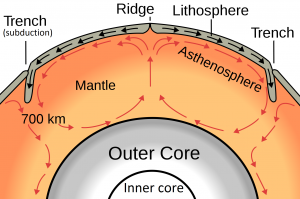Fundamentals of Plate Tectonics

Plate tectonics is the model or theory that has been used for the past 60 years to understand and explain how the Earth works—more specifically the origins of continents and oceans, of folded rocks and mountain ranges, of earthquakes and volcanoes, and of continental drift. We will explore the concept of plate tectonics further in Lab 1, but is introduced here because it includes concepts that are important to many of the topics we will cover in the lab this semester.
Key to understanding plate tectonics is an understanding of Earth’s internal structure, which is illustrated in Figure I6 Earth’s core consists mostly of iron. The outer core is hot enough for the iron to be liquid. The inner core—although even hotter—is under so much pressure that it is solid. The mantle is made up of iron and magnesium silicate minerals. The bulk of the mantle surrounding the outer core is solid rock, but is plastic enough to be able to flow slowly. The outermost part of the mantle is rigid. The crust—composed mostly of granite on the continents and mostly of basalt beneath the oceans—is also rigid. The crust and outermost rigid mantle together make up the lithosphere. The lithosphere is divided into about 20 tectonic plates that move in different directions on Earth’s surface.
An important property of Earth (and other planets) is that the temperature increases with depth, from close to 0°C at the surface to about 7000°C at the centre of the core. In the crust, the rate of temperature increase is about 30°C every kilometre. This is known as the geothermal gradient.

Heat is continuously flowing outward from Earth’s interior, and the transfer of heat from the core to the mantle causes convection in the mantle (Figure I7). This convection is the primary driving force for the movement of tectonic plates. At places where convection currents in the mantle are moving upward, new lithosphere forms (at ocean ridges), and the plates move apart (diverge). Where two plates are converging (and the convective flow is downward), one plate will be subducted (pushed down) into the mantle beneath the other. Many of Earth’s major earthquakes and volcanoes are associated with convergent boundaries.
Media Attributions
- Figure I6: © Steven Earle. CC BY.
- Figure I7: Oceanic Spreading by Surachit. Public domain.
The concept that the Earth’s crust and upper mantle (lithosphere) is divided into a number of plates that move independently on the surface and interact with each other at their boundaries.
The metallic interior part of the Earth, extending from a depth of 2900 kilometres to the centre.
The middle layer of the Earth, dominated by iron and magnesium rich silicate minerals and extending for about 2900 kilometres from the base of the crust to the top of the core.
A mineral that includes silica tetrahedra.
The uppermost layer of the Earth, ranging in thickness from about 5 kilometres (in the oceans) to over 50 kilometres (on the continents).
The rigid outer part of the Earth, including the crust and the mantle down to a depth of about 100 kilometres.
A region of the lithosphere that is considered to be moving across the surface of the Earth as a single unit.
The rate of increase of temperature with depth in the Earth (typically around 30˚ C/km within the crust).
When part of a plate is forced beneath another plate along a subduction zone.

